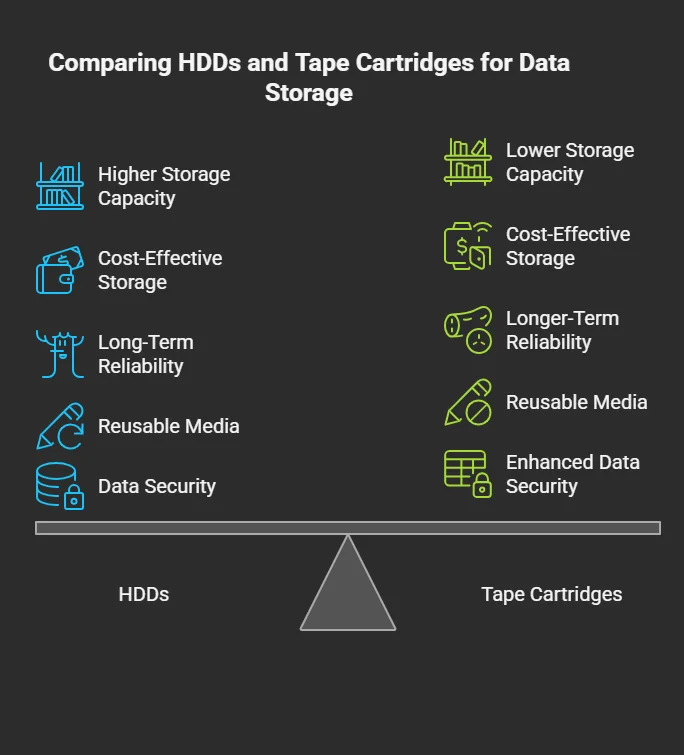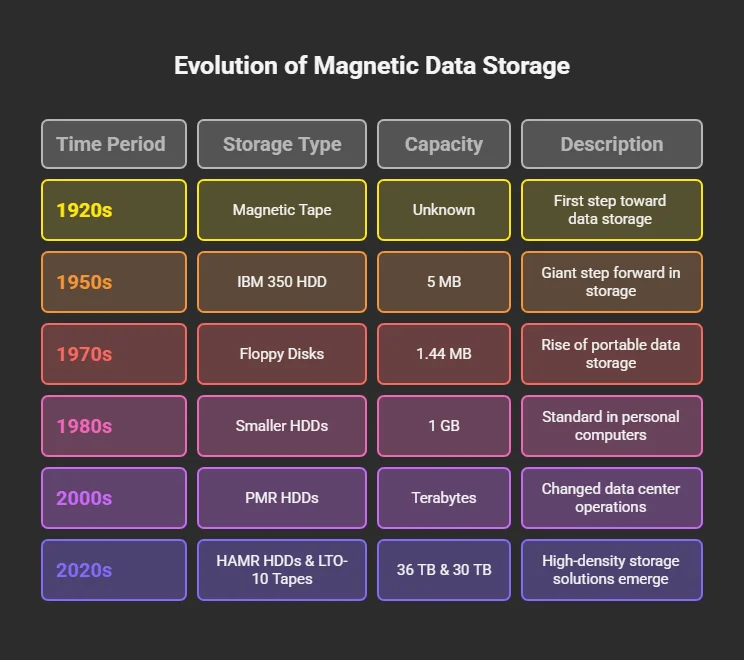Magnetic Data Storage Devices: Guide to Technology and Trends
Introduction
Magnetic data storage methods have revolutionized the digital world for more than sixty years. They store data by encoding it as binary 0s and 1s on a magnetic medium. Since the first hard disk drive (HDD) came out in 1956, magnetic data storage devices have come a long way. They can now contain up to 36 terabytes of data. They will still be useful in 2025 since they are affordable, reliable, and have a lot of storage. Solid-state drives (SSDs) and cloud storage are both popular, but magnetic data storage devices are still the ideal choice for data centers, backups, and archive systems. The book talks about how magnetic data storage devices work, the numerous types, their advantages and cons, their functions, and what the future holds for them. The text makes the subject easy to understand. For more details, please read this article.
How Magnetic Storage Works
Magnetic data storage devices store information by making small sections of a tape or disk magnetic. In some places, the magnetic field exhibits binary data. To put it simply:
- Magnetic Medium: The tape or disk has a thin layer of ferromagnetic material, like iron oxide or FePt, on top of it. It stores magnetized patterns for subsequent usage.
- Read/Write Heads: These parts write data by magnetizing areas and read data by finding fields. They are a few nanometers higher than the medium.
- Data Encoding: Changes in magnetic flux exhibit 0s and 1s. Tracks and sectors make it easy to find the information you need.
- Mechanical Movement: The platters of an HDD spin at speeds between 5,400 and 15,000 RPM. An actuator moves the heads to the right track. Tapes go right past the skull.
HDDs enable computers to find and access data quickly and randomly. Backups using magnetic tapes can help you restore your data. This form of storage is slower, but it’s cheaper. This type of storage is reliable since it keeps data safe even when the power goes out. Magnetic data storage devices can swiftly handle a lot of data because they are so precise.
Types of Magnetic Data Storage Devices
Magnetic data storage devices come in various forms, each designed for specific needs. Below is a comparison with SSDs for context:
|
Device Type |
Capacity Range |
Access Speed |
Use Cases |
Pros |
Cons |
|
HDD |
500 GB–36 TB |
Medium (ms) |
PCs, servers, data centers |
High capacity, low cost per GB |
Slower than SSDs, moving parts |
|
Magnetic Tape |
Up to 30 TB (LTO-10) |
Slow (seconds to minutes) |
Archival storage, backups |
Very high capacity, low cost |
Sequential access, slow retrieval |
|
Floppy Disk |
1.44 MB |
Slow |
Legacy systems |
Portable, inexpensive |
Low capacity, obsolete |
|
SSD |
250 GB–8 TB |
Fast (μs) |
High-performance computing |
Speed, durability |
Higher cost per GB |
Hard Disk Drives (HDDs)
Hard disk drives (HDDs) are the most used type of magnetic data storage. They use spinning disks that are covered in magnetic material. HDDs are good for PCs, servers, and data centers because their read/write heads may access data in any order. Using Heat-Assisted Magnetic Recording (HAMR), Seagate’s Exos M series will be able to hold up to 36 TB by 2025. Designs that utilize helium reduce power consumption and increase data density, making HDDs effective for storing large amounts of data.
Magnetic Tapes
Magnetic tapes store data on long strips that are magnetic. LTO-10 cartridges can hold 30 TB of data (75 TB when compressed), and LTO-9 cassettes can hold 18 TB. These are fantastic for backups and storage because they are affordable and contain a lot of space. Tapes may last for 30 years if you take excellent care of them, which is ideal for storing data for a long time.
Floppy Disks
Floppy disks used to be a common way to move files; however, they are no longer useful. These disks were made of plastic and could hold 1.44 MB. They are still used in some specialized old systems, although USB drives and cloud storage have taken their place. They aren’t useful anymore because they don’t hold enough.
Magnetic Random Access Memory (MRAM)
MRAM is a new kind of magnetic data storage technology. It stores data in magnetic tunnel junctions, which means it doesn’t lose information and is as fast as an SSD. MRAM isn’t widely used currently, but it has potential for future uses because it lasts a long time and uses little power.
Magnetic Recording Techniques
In order for magnetic data storage devices to efficiently encode data, they require complicated recording methods.
The data is arranged in a horizontal fashion in the longitudinal magnetic recording (LMR) system. Although its population was restricted, it maintained its dominance until the 2000s.
Through the use of perpendicular magnetic recording (PMR), bits are aligned vertically to achieve higher density. When it comes to storage on the terabyte scale, the majority of solid-state drives (HDDs) use PMR.
Heat-Assisted Magnetic Recording (HAMR): This technique makes it simpler to store more data by heating the medium with lasers, which are used to heat the medium. In 2025, it will be able to function with drives that are 36 terabytes in capacity.
This technique, known as microwave-assisted magnetic recording (MAMR), involves the utilization of microwaves to write data, thereby increasing density without the use of heat.
Tracks are stacked on top of each other in shingled magnetic recording, also known as SMR, to increase the amount of data that can be stored on the drive.
Magnetic data storage devices are able to store more data and become more valuable as a result of these technologies, which enables them to maintain their competitive edge in a market that is constantly evolving.
Comparison HDDs and Tape Cartridges for Data Storage
There are many benefits to using magnetic data storage devices:
- High Capacity: HDDs can hold up to 36 TB, while each tape cartridge can carry up to 30 TB.
- Cost-Effectiveness: They are cheaper per gigabyte than SSDs; therefore, they are excellent for holding a lot of data.
- Reliability: Magnetic media can store data for years, while cassettes can store it for up to 30 years.
- Reusability: You can write over media several times, which saves you money.
- Data Security: Offline tapes keep your data safe from online attacks, and encryption makes them even safer. Magnetic data storage devices are the best way to keep a lot of data because they can do all of these things.

Disadvantages of Magnetic Storage
The following are some issues with magnetic data storage devices:
- Reduced Speeds: HDDs are slower than SSDs due to the presence of moving elements.
- Failure to maintain: The movable components of your hard disk drive (HDD) may result in its failure.
- Power Consumption: Solid-state drives (SSDs) consume less power than hard drives (HDDs), rendering them less practical.
- Heat and commotion: The spinning of platters generates heat and commotion.
Data can be corrupted by temperatures that are either too hot or too frigid or by strong magnetic fields. SSDs are more suitable for short-term tasks due to these issues.
Applications of Magnetic Data Storage Devices
Hard drives (HDDs) are utilized to store backups, data stored in the cloud, and commercial applications in data centers, among many other uses for things that store information magnetically. These folks deal with Amazon Web Services and Google Cloud. Because they save data securely for decades, tapes are crucial for rule-abiding organizations like healthcare and banking.
Hard drives are used by a variety of home equipment, including personal computers, gaming consoles like the PlayStation 5, and digital video recorders (DVRs) that capture television programs.
Science Many researchers in domains such as genetics, astronomy, and climate models rely on magnetic data storage devices to house massive amounts of data.
You may always record video for security systems using hard drives, which is excellent for surveillance.
In 2025, magnetic recording devices will be widely employed due to their versatility.
Magnetic Storage vs. Other Technologies
Magnetic data storage devices compete with other storage solutions, each with unique strengths:
Vs. Solid-State Drives (SSDs)
Flash memory is used in SSDs, which makes them speedier and more durable. Magnetic data storage systems can hold more data for less money. SSDs are quiet and use less power than HDDs, which are louder and use more power.
Vs. Optical Storage
Optical discs, such as CDs, DVDs, and Blu-rays, may hold up to 50 GB, which is a lot less than HDDs. They are portable; however, magnetic data storage systems are better for storing big amounts of data.
Vs. Cloud Storage
Cloud storage lets you scale up and access your files from anywhere, but you need an internet connection and a subscription. Magnetic data storage devices work with cloud solutions by providing offline security and one-time pricing.
Vs. RAID Configurations
RAID combines multiple drives for redundancy or performance. Magnetic data storage devices like HDDs are often used in RAID setups for cost-effective, high-capacity storage. Magnetic data storage devices excel in high-capacity, offline scenarios, while each technology caters to specific needs.
Historical Evolution of Magnetic Data Storage Devices
Magnetic data storage devices have been around for almost a hundred years:
• In the 1920s: Fritz Pfleumer invented magnetic tape for recording sound, which was the first step toward storing data.
• In the 1950s: IBM’s 350 HDD stores 5 MB on fifty 24-inch disks, which was a giant step forward.
• In the 1970s: saw the rise of floppy disks, which could hold 1.44 MB of data.
• In the 1980s, smaller hard disk drives (HDDs) reached a capacity of 1 GB and became standard in personal computers (PCs).
• In the 2000s: PMR increased the capacity of hard drives to terabytes, changing the way data centers worked.
• In the 2020s, HAMR technology allows hard drives to store 36 TB of data, while LTO-10 tapes can hold 30 TB.
This change shows how flexible magnetic data storage technologies are.

Current Trends in Magnetic Storage Technology
In 2025, magnetic data storage devices are likely to get better.
Seagate’s HAMR drives have a density of more than 1 TB/in², which means they can store up to 36 TB of data.
• MAMR: Western Digital’s MAMR is a data storing device that uses microwaves to reduce the amount of space it needs, which makes it work better.
• SMR: This technology adds more space by stacking tracks vertically. There are big business projects that use it.
According to research, LTO-10 tapes can hold 30 TB of data, and LTO-11 tapes will be able to hold 45 TB by 2027.
Spintronics studies how electron spin can create faster, denser storage systems that may replace hard drives.
When there is a lot of data, magnetic data storage methods are still better because they can hold more.
Future of Magnetic Data Storage Devices
Things look favorable for magnetic data storage devices.
- More space: By 2028, HAMR could make 50 TB HDDs, and by 2030, it could make 100 TB HDDs.
- Tape technology is getting better: LTO tapes may be able to hold 100 TB cartridges and have a data density of 200 Gb per square inch.
- Magnetic Nanoparticles: Because they are tiny, magnetic particles may store a lot of information.
- Skyrmions: Magnetic vortices make it possible to create storage systems that are high-density and low-power.
Magnetic data storage devices will make it possible for AI to do data analytics in data centers.
These improvements guarantee that magnetic data storage devices will still be useful for storing data in the future.
Magnetic Storage in Data Security and Recovery
Magnetic data storage systems are essential for keeping data safe:
- Backups: While not connected to the internet, tapes create backups that are safe from ransomware and intrusions.
- Archival: Tapes keep data for 30 years, which is excellent for following the rules.
- Data Recovery: Some companies can get data back from broken hard drives, but not all of them are successful.
- Modern magnetic data storage devices employ AES-256 encryption to enhance their security.
These qualities render magnetic data storage systems a dependable choice for secure storage.
Sustainability and Magnetic Data Storage Devices
Magnetic data storage systems necessitate a challenging design process:
- Access Methods: HDDs enable users to access data at random, which simplifies the process of locating it. Data is stored on cassettes through sequential access.
- Run-Length Limited (RLL) and Partial-Response Maximum-Likelihood (PRML) are coding schemes that ensure the validity of the data.
- Materials: Ferromagnetic alloys, such as FePt, are employed in contemporary solid-state disks (HDDs) to accommodate a substantial amount of data.
The functionality and dependability of magnetic data storage systems are contingent upon these technical specifications.
Magnetic Storage in Education and Research
Magnetic data storage is beneficial to researchers and academics since it:
A school’s ability to manage student records and enable e-learning is made possible by hard disk drives.
Researchers collect a large amount of data for the purposes of studying physics, climate, and genetics.
Magnetic data storage articles are published by IEEE Transactions on Magnetics, which is a resource utilized by educational institutions.
These examples illustrate the possible impact that magnetic data storage could have on the educational system.
Common Misconceptions About Magnetic Storage
There are some myths concerning magnetic data storage devices:
- Fragility: HDDs can survive 5 to 10 years if you take care of them, which goes against the belief that they are fragile.
- Obsolescence: Magnetic data storage systems are still important for applications with a lot of space.
- Slow Performance: Most modern hard drives are fast enough for most tasks.
Clearing out these misunderstandings helps people choose the right magnetic data storage device.
FAQs About Magnetic Data Storage Devices
Conclusion
Magnetic data storage devices remain a significant component of digital storage in 2025. They are essential for data centers, backups, and archiving due to their superior capacity, cost-effectiveness, and reliability. Emerging technologies such as HAMR, MAMR, and skyrmions will enhance their future value. Magnetic data storage systems are particularly advantageous, as they may energize PCs and facilitate AI in data analysis. Investigate this technology to comprehend its significance in a data-driven world.

